The Memories of Z80 Past: Zaxxon and Future Spy
The Sega System 1 was not Sega’s first arcade board system; of course, they had been releasing arcade games since the 1970’s. Of course, once one moves before 1983, things get more complicated thanks to the Sega/Gremlin split, and the lack of parts standardization pre-JAMMA, but we can probably handle a year or so before. But first, an irrelevant digression.
Ikegami Tsushinki
Sega had been making arcade games in-house for ages, especially if you count electro-mechanical games like Periscope (hook that up to your Supergun!). But as we’ll see, not all arcade games are completely in-house. Some use contract developers.
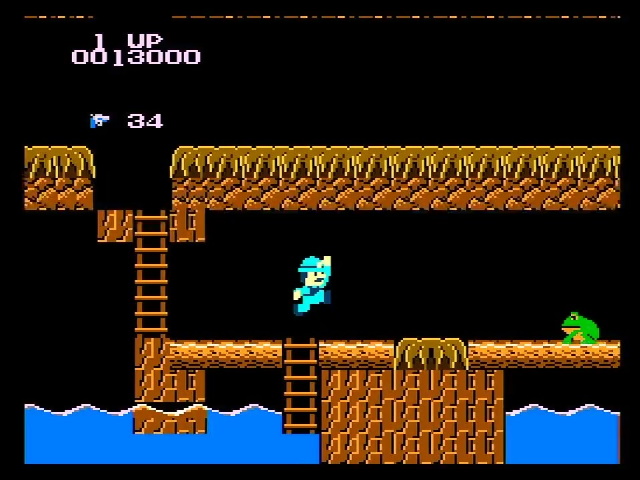
If you read the Pitfall II blog post you might be a bit concerned; after all, contract developer Micronics is often blamed for the poor quality and general jankiness of the NES’s Super Pitfall. But there’s nothing inherently wrong with contract developers; they work to their employers’ design, quality control, and of course, budget.
For example, a little irrelevant game you may have heard of called Donkey Kong was designed by Nintendo, but was coded by and even used an arcade board designed by a company called Ikegami. Nintendo was just getting into arcade games, after all, and hadn’t built that capability in-house just yet. We know this because while it isn’t written on the circuitboard, it was written to the ROMs themselves, in the form of a charming hidden message.
CONGRATULATION !
IF YOU ANALYSE
DIFFICULT THIS
PROGRAM,WE WOULD
TEACH YOU.*****
TEL.TOKYO-JAPAN
044(244)2151
EXTENTION 304
SYSTEM DESIGN
IKEGAMI CO. LIM.
Ikegami refers to Ikegami Tsushinki Co. Ltd; they’re usually said to be this company, which is still in business selling broadcast equipment.
But back in Nintendo and Ikegami’s home country of Japan, they found themselves in court against each other. Ikegami believed their contracts gave them the exclusive right to manufacture the circuit boards for games like Donkey Kong and its predecessor Radar Scope. Nintendo disagreed, manufacturing its own boards, and then reverse-engineered Ikegami’s arcade board to produce 1982’s Donkey Kong Jr.. The two companies didn’t resolve their lawsuit until 1990, at which point Ikegami had left the arcade business.
Of course, these lawsuits and contracts are mostly still kept under lock and key, so we don’t know all their terms or even the final settlement between Nintendo and Ikegami. What we do know is that Ikegami did not only work with Nintendo, they also worked with Nintendo’s competition, especially after the 1982 lawsuit.
Zaxxon
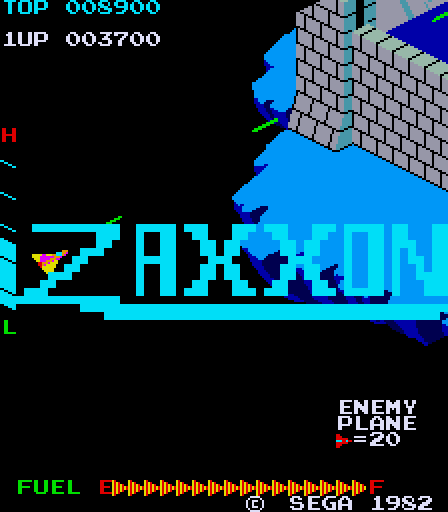
Zaxxon is an arcade classic. It gets its name from the “axonometric” perspective used by the game art, though nowadays we tend to call this style isometric, a subset of axonometric perspectives. This allowed it to be the first shooter to truly have three dimensions, as you can move your ship up and down on the z-axis, back and forth on the x-axis, and your ship constantly moves forwards over an elaborate landscape. Compare this to one-dimensional games like Space Invaders or even 1981’s hit Galaga and you can really see what an advancement Zaxxon was.
The above screenshot is from the MAME emulator, rather than being from actual hardware. This is done for two reasons; the more important one, though, is the ability to use MAME’s graphics viewer. This allows us to see all the tiles rendered, and we can see two interesting ones. (I got this knowledge from The Cutting Room Floor, a truly wonderful wiki that I’ve had some contributions to myself)

The relevant tiles are at 4B and 4C; they show the letters “ITC” in a circle. This is generally believed to be the logo of Ikegami Tsushinki Co. Ltd.; the contract firm again applied their expertise to Zaxxon, now in the service of Nintendo’s competitor, Sega Enterprises. This gets funnier when we look at a game that used the upgraded version of the Zaxxon arcade hardware; Congo Bongo.

Congo Bongo is essentially an isometric version of Donkey Kong, complete with the ape who serves as your goal. You could call it a ripoff, but it does play quite a bit differently thanks to the extra dimension, and while Donkey Kong’s designers and copyright holders didn’t work on it, some of the same engineers likely did! After all, it too has the Ikegami Tsushinki logo hidden in its tiles.
The other reason I used MAME screenshots in this section is that I don’t have a Zaxxon or a Congo Bongo board. The game that’s the centerpiece of our blog post today is another game Sega released that used Zaxxon’s hardware: Future Spy.
The Sega Zaxxon Board
So let’s talk about that Sega Zaxxon hardware. While my board is a Future Spy today, it was a Zaxxon board originally. In fact, the EPROMs on the circuitboard mostly bear stickers that, while crossed out, still show that the very same ROMs served this in its days of playing Zaxxon, just rewritten for the new job.
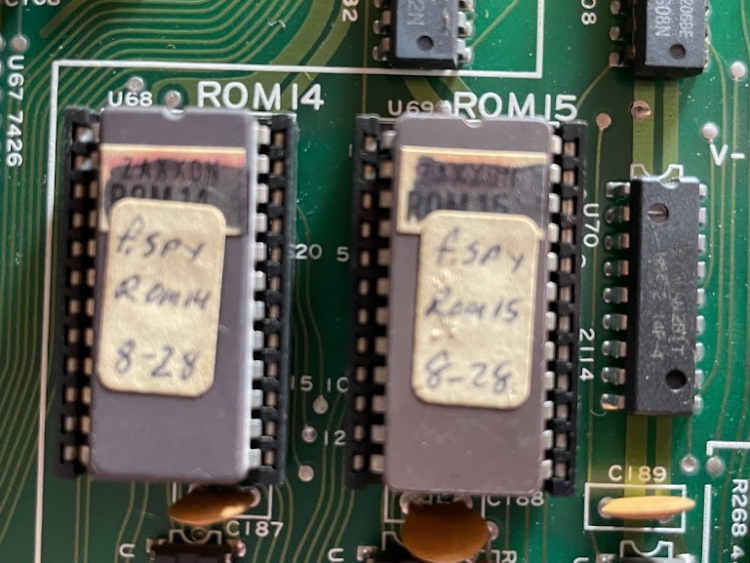
As usual, this sort of conversion is baffling in 2022, when Zaxxon is a true classic and Future Spy a completely forgotten title without even a Wikipedia article to its name. But in 1984, Zaxxon was old news, and the arcade industry thrived on novelty. I would assume that Future Spy mostly sold as conversion kits for Zaxxon cabinets and boards, as a last way to get some life out of some money-losing cabinets.

The Zaxxon hardware is made up of two different circuitboards joined by several ribbon cables and another connection down near the edge connector. (Not JAMMA, you can see an adapter here) Compare the two large boards on the left in the photo above to the smaller board on the right; that one is the Sega System 1 game My Hero. Both boards utilize a lot of discrete logic, but the System 1 board has more consolidated IC’s, and is much more densely packed.
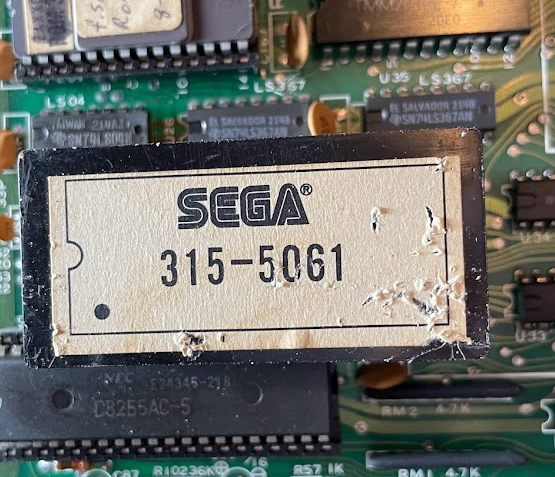
Indeed, as far as I can tell, this “315-5061” IC, which consists of a large plastic block in an IC socket, is the only custom block on the board. It seems to be the main CPU, a Z80, but with some sort of proprietary opcode mapping. This would prevent arcade operators from just burning their own EPROMs without giving Sega (or their US distributor, Bally Midway) a cut.
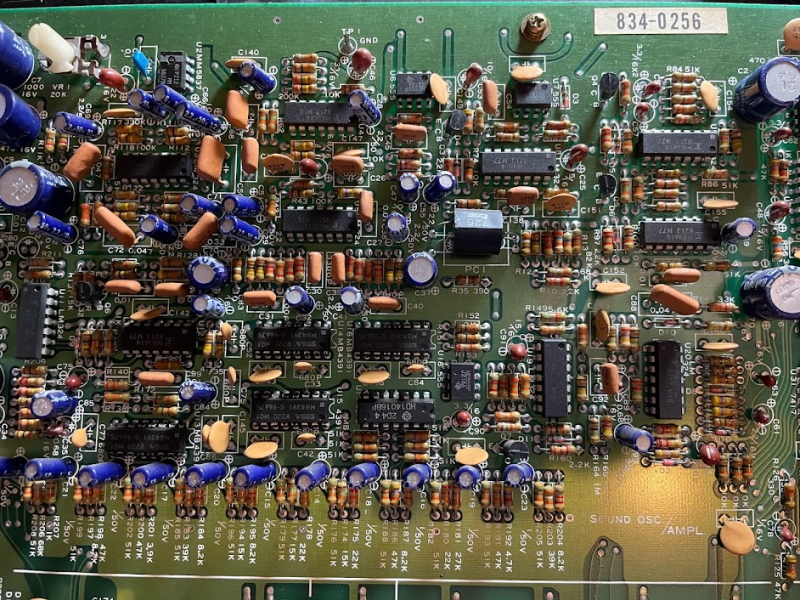
An interesting section is this “SOUND OSC./AMPL.” on the top circuitboard. The sound effects appears to be generated using analog circuitry, rather than a sound synthesizer. That means this whole section on the System 1 board is replaced by the two tiny little SN76489 synthesizer chips. This is also the same way Donkey Kong generated its sounds, drawing more evidence for the Ikegami Tsushinki connection. (Remember, Ikegami both manufactured the boards and worked on program code) Note that Donkey Kong used an external amplifier, while the Sega hardware uses an amplifier on the board, like later JAMMA boards.
It also raises an interesting challenge for game designers. Zaxxon’s hardware is hardcoded for Zaxxon’s sound effects. Therefore, since Future Spy seems to have been designed for a drop-in EPROM replacement on Zaxxon boards, it has to use the same sound effects. Note that this doesn’t apply for all “Sega Zaxxon hardware” games; for example, Congo Bongo uses an upgraded design that adds SN76489 chips.

Finally, the Zaxxon board has another trick up its sleeve: that axonometric perspective is partially implemented in hardware. On the left you can see the area as stored in the game’s tilemap (which again, MAME lets us see). From the tilemap perspective, the map is scrolling left to right. But the game hardware skews it, thus giving us a diagonal movement.
You can also see that the gap in the first castle is implemented partially using sprites; sprites are not skewed like the background tilemap, so the game actually has additional stored graphics for the wall in sprite form that are pre-skewed.
Every released game using the Zaxxon hardware seems to use this skewed perspective. Interestingly, Sega did have two prototype games in 1983, Ixion and Razzmatazz, that used similar hardware but with the skew disabled, and those games did not use the isometric perspective at all. However, both games seem to have been developed by Sega Electronics (the former Sega/Gremlin), and neither survived that division’s sale to Bally/Midway.
Finally, Future Spy
I keep calling Future Spy “Final Spy” instead. Which is probably just as apt of a title; despite the name, the game has very little to do with the future or with espionage.
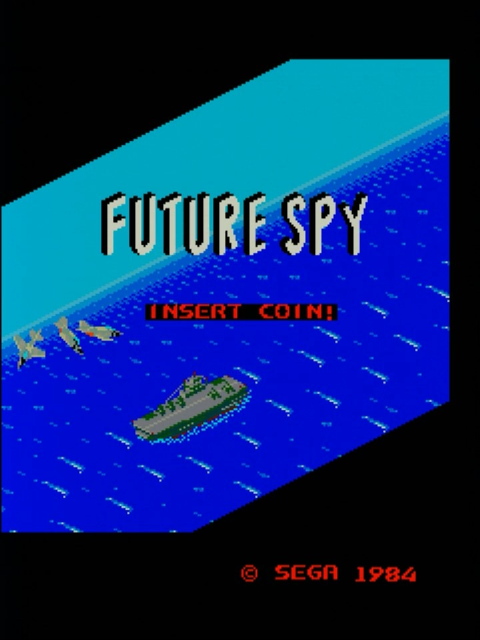
Considering how hard-coded the Zaxxon hardware is to being, well, Zaxxon, it makes sense that Future Spy is itself also an isometric shooter. After all, this makes reusing the sound effects less of an oddity, and plays to the platform’s strengths.

At first glance, you might mistake this game for just being Zaxxon set on Earth. Actually, the gameplay is quite different. You see, between the release of Zaxxon in December 1981, and the release of Future Spy in September of 1984, a game came out that swept the video game shooter by storm: December 1982’s Xevious. The screenshots are from the PC Engine release rather than the arcade board, for the simple reason that I have one and not the other.

For whatever reason, Xevious seems to have had much less of a cultural impact in my home country of the United States; I’m not sure if this is because of Namco’s decision to cut ties with Midway, who had distributed past hits like Galaga and Pac-Man, and instead go with Atari right in the period where the company fell apart, or just because of the vagaries of the market.
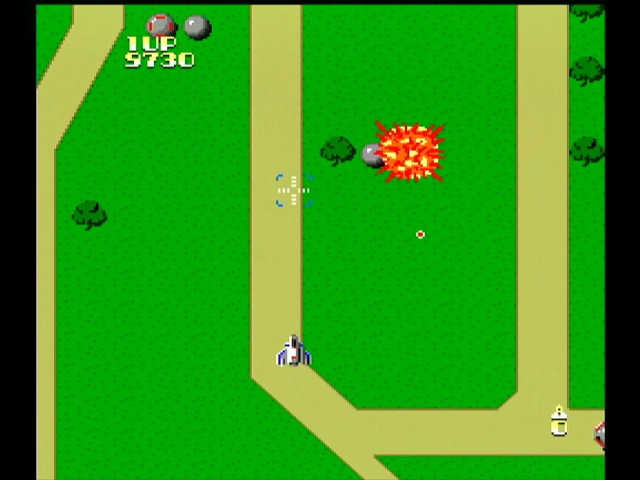
Xevious, like Zaxxon, brings three dimensions to shooting. But it does so in quite a different way. You can move freely in the x-axis, can move in the y-axis within a constantly scrolling landscape, but can’t move in the z-axis at all. Instead, your access to things below you is handled with your weapons. You have two weapons: a gun which fires forward, and a missile which heads downward to where your targeting reticle shows.
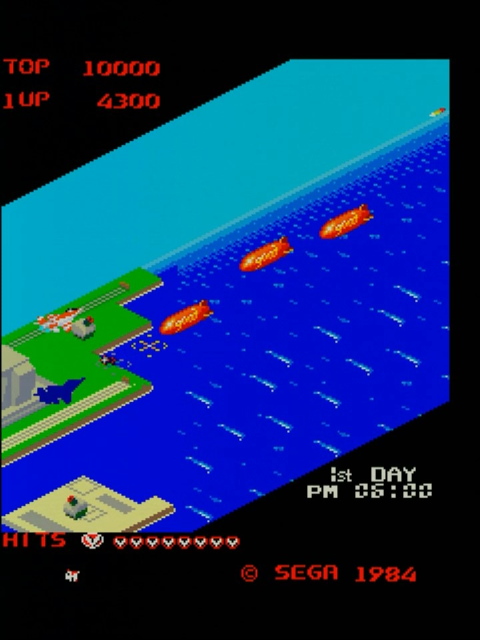
This is exactly how Future Spy works, even with the targeting reticle. Xevious was a huge hit in Japan, so it makes sense that it’d be influential here. And that’s not to call it a bland ripoff. The game definitely has its own personality, with the smaller play area and the more realistic military setting. It’s a game that really would benefit from a rousing soundtrack, though sadly it only has Zaxxon’s static background noise.
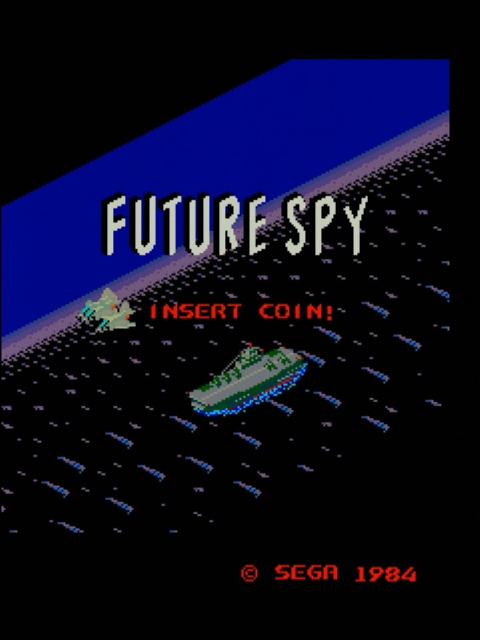
A nice touch is the game’s day-night cycle. You can see the time of day, and the palettes change to match. And if you get a game over at night, the attract screen will show the title screen at night, a nice touch. (It resets back to daytime after a cycle)
Technical nonsense
The screenshots above were captured using the Axunworks Supergun Mini feeding into the GBS 8200 with custom firmware. Initially, I saw a lot of garbage in screen captures, but this was eliminated by use of oversampling in the GBS configuration.

A test switch on the board allows access to a RAM test, which doesn’t appear to have any other functions.
A strange history
There are a few things I find strange about Future Spy. First off, the game contains no clues of being made by Ikegami Tsushinki. Sega Retro credits it to Sega R&D 1, the division that would go on to make quite a few of Sega’s well-known arcade games. Was Future Spy, like Donkey Kong Jr., based on an unauthorized clone of Ikegami Tsushinki hardware? Or perhaps was it authorized, to give more life to Zaxxon boards as Ikegami exited the scene.
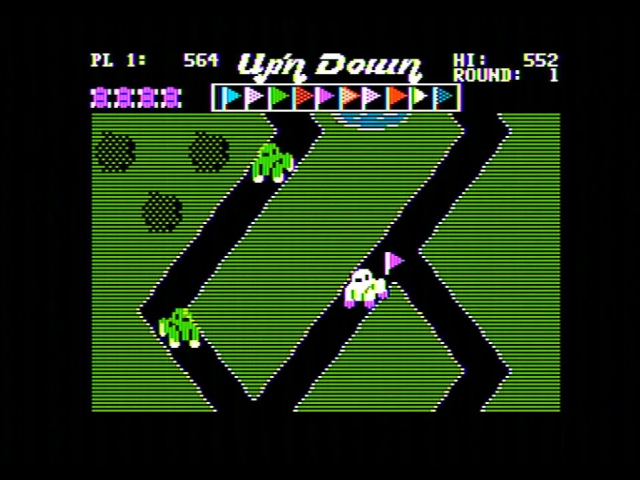
The other question is why it existed; by 1984 Sega had the System 1, which was an in-house board that had several more advanced features, like hardware collision detection and a separate sound CPU. On the other hand, the System 1 never really did the axonometric perspective justice; the closest it got was Up n’ Down, which while I’ve used the Apple ][ version for fun for the above screenshot, is the same general perspective on System 1 and not really the same thing. Maybe Sega or Midway really did have warehouses of Zaxxon stock taking up space. In any case, an interesting look at the past through a game that is mostly forgotten today.
